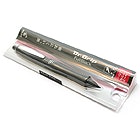

Jetpens stocks it every few weeks and it sells out quickly, but I waited anyway because I felt they were the most reliable option. This pencil is not readily available in the US, so there are really only three options to get it here Ebay, Japanese Amazon, or Jetpens. I think that’s quite beneficial for this pencil, since the sliding sleeve works better with steeper angles. My Rotring naturally lays on the webbing between my thumb and index finger, but I tend to hold the Nero across my index finger itself, which leads to a much steeper writing angle. The center of mass is near the top of the grip, which for me means it’s well below the top of my hand. I’m very used to Rotring’s perfect balance (right on the “o” in “Rotring”), so it was also weird to use a bottom-heavy pencil. It does waste a little bit more lead at the end than most mechanisms, but I’m not too bothered by that. It’s quite weird at first, but it’s really easy to get used to. Writing with this pencil is remarkably low-maintenance, as you don’t need to advance it and the 0.2mm lead does a better job keeping itself sharp than any 0.5mm Kuru-Toga mechanism ever could. The only problem for pocket-safety is that the spring-loaded tip fully extends itself even if you just partially press the button, so it can pop out if it gets knocked around. This means there’s a slight movement when it touches the paper, but the lead itself does not move and there is no perceptible side-to-side play.

The sleeve is pushed back as you write, and when you lift the tip the sleeve extends again, pulling the lead through the one-way clutch. The auto-advance is very simple there’s a one-way clutch, and the sliding sleeve is spring-loaded. People complain that the knock is mushy, which it kind of is after the tip is extended, but if you’re manually advancing lead then you’re doing it wrong. The sliding sleeve locks into the nose cone when it’s retracted, and pops out with a satisfying click when extended. There are two notches that lock the clip’s rotation situated 180º apart, so you can adjust it to be right- or left-handed. The inner lead reservoir is plastic, but terminates in a metal collet on the eraser end (plastic eraser collets tend to expand over time). The eraser cap is made from metal, and it has a small amount of play with the body that causes it to rattle I fixed that with a small piece of packing tape, similar to the 800 tape fix. It should be quite hard-wearing, but I haven’t had it long enough to speak of long-term wear. The iron-plastic material is weakly magnetic, denser, and gets noticeably cold to the touch. The barrel is made from two materials, iron-particle packed nylon and either raw nylon or ABS (I’m not sure which). Pentel definitely falls into the latter camp. There are two possible reasons one would use plastic because it’s cheaper, or because they feel it’s better suited to the purpose. Pretty damn good.īut that’s enough about 0.2mm lead, let’s look at the pencil. It’s gotten to the point where I feel like 0.5mm is just too blunt a tool for my math, so I’ve decided to try 0.2mm. But at some point, I think at the beginning of my PDE class, there was a fundamental shift. At the time, and indeed for years, it served my purposes perfectly. I got my 800 at the very onset of my love of math, some time just before Algebra 1.

However, there is one issue I cannot fix: The lead is too thick. I’ve taken it to bits to fix every little issue I’ve ever had with it, including the tip-wobble. It’s a great pencil exceedingly well built, reliable, and good-looking.

I’ve had a Rotring 800 for the past several years, and I’ve used it nearly every day in that time.


 0 kommentar(er)
0 kommentar(er)
